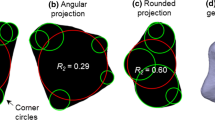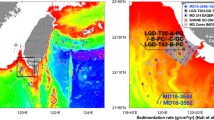Abstract
Roundness reflects the transport history of gravels, but methods of determining roundness in the field have had little progress over decades. In this study, we introduce a new method to quantify the roundness of gravels on outcrops by combining field digital photographs and laboratory image processing. The Chihsia Formation in northern Chaohu City, Anhui Province, South China deposited different types of calcirudites that were formed in carbonate slope environment, including light-color limestones gravels originated from platform and dark-color limestones matrix. Using this method, we calculate the roundness of gravels from different kinds of calcirudites and characterize the geometry of the carbonate slope of the Permian-aged Chihsia Formation in Chaohu area and conclude that the gravels in calcirudites are primarily sub-angular (0.11–0.28), sub-angular to rounded (0.21–0.43), and sub-rounded to rounded (0.36–0.58) in the upper, middle and lower slopes which have dip angles of 15–25°, 30–35° and 1–10°, respectively. These results show that this method not only can be used for quantitative studies of the roundness of gravel-size particles in carbonate slope environments, but may also has broad applications for investigations of the roundness of gravels in other settings.






Similar content being viewed by others
References
Adams EW, Schlager W (2000) Basic types of submarine slope curvature. J Sediment Res 70:814–828
Angela LC, Tom WA, David AR, Robert AS (2010) Geological field techniques. Wiley-Blackwell, Oxford
Bahamonde JR, Kenter JA, Della PG, Keim L, Immenhauser A, Reijmer JJ (2004) Lithofacies and depositional processes on a high, steep-margined Carboniferous (Bashkirian-Moscovian) carbonate platform slope, Sierra del Cuera, NW Spain. Sediment Geol 166:145–156
Barrett PJ (1980) The shape of rock particles, a critical review. Sedimentology 27:291–303
Blot SJ, Pye K (2008) Particle shape: a review and new methods of characterization and classification. Sedimentology 55:31–63
Boggs SJ (2006) Principles of sedimentology and stratigraphy, 4th edn. Pearson Prentice Hall, Upper Saddle River
Boggs SJ (2009) Petrology of sedimentary rocks, 2nd edn. Cambridge University Press, Cambridge
Chang YF, Liu XP, Wu YC (1991) Copper-iron belt of the middle and lower reaches of the Yangtze River. Geological Press, Beijing
Coniglio M, George RD (1992) Carbonate Slopes. In: Walker RG, James NP (eds) Facies model: response to sea level change. Geological Association of Canada, Waterloo, pp 349–374
Diepenbroek M, Bartholomä A, Ibbeken H (1992) How round is round? A new approach to the topic ‘roundness’ by Fourier grain shape analysis. Sedimentology 39:411–422
Dobkins JE, Folk RL (1970) Shape development on Tahiti-Nui. J Sediment Pet 40:1167–1203
Drevin GR (2000) Using entropy to determine the roundness of rock particles. Proc ICSP 2:1399–1401
Drevin GR, Vincent L (2002) Granulometric determination of sedimentary rock particle roundness. In: Proceedings of international symposium on mathematical morphology, Sydney, Australia
Du YL, Li SY, Jia ZH, Wang S (2012) Re-discussion on the origin of the rudstone in Middle Permian Qixia Formation along Lower Yangtze River of Anhui Province. Geol Rev 58:426–433
Feng ZZ, Yang YQ, Jin ZK, He YB, Wu SH, Xin WJ, Bao ZD, Tan J (1996) Lithofacies paleogeography of the Permian of South China. Acta Sedimentol Sin 14:1–10
Goossens D (1987) Interference phenomena between particle flattening and particle rounding in free vertical sedimentation processes. Sedimentology 34:155–167
Hayakawa Y, Oguchi T (2005) Evaluation of gravel sphericity and roundness based on surface-area measurement with a laser scanner. Comput Geosci 31:735–741
Jiang NY (1994) Permian palaeogeography and geochemical environment in Lower Yangtze Region. Petroleum Industry Press, Beijing
Jonathan PS (1965) Significance of constituent composition, texture, and skeletal breakdown in some recent carbonate sediments. J Sediment Pet 35:71–90
Kenter JA (1990) Carbonate platform flanks: slope angle and sediment fabric. Sedimentology 37:777–794
Kenter JA, Schlager W (1989) A comparison of shear strength in calcareous and siliciclastic marine sediments. Mar Geol 88:145–152
Krumbein WC (1941) Measurement and geological significance of shape and roundness of sedimentary particles. J Sediment Pet 11:64–72
Lanfranchi A, Berra F, Jadoul F (2011) Compositional changes in sigmoidal carbonate clinoforms (Late Tithonian, eastern Sardinia, Italy): insights from quantitative microfacies analyses. Sedimentology 58:2039–2060
Large DE (1986) Sediment-hosted submarine exhalative lead-zinc deposits review of their geological characteristics and genesis. In: Wolf KH (ed) Handbook of strata-bound and stratiform ore deposits 9. Elsevier, Amesterdam, pp 469–508
Li SY, Yue SC (2002) Sedimentation on a Carbonate slope of Permian Qixia Formation in Chaohu Region, Anhui. Acta Sedimentol Sin 20:7–12
Li SY, Hong TQ, Jing FQ, Liu H, Hu YQ (2001) Allochthonous carbonate rocks in the Swine limestone member of The Permian Chihsia Formation of Chao Xian, Anhui. J Stratigr 25:69–74
Li SY, Meng QR, Wan Q, Kong WL, He G (2008) Deposition of carbonate slope and ore-forming in Permian strata in the Middle-Lower Reaches of the Yangtze River, east China. Acta Pet Sin 24:1733–1744
Li SY, Wang S, Wan Q, Du YL, Kong WL, He G (2012) Deposition and evolution of the carbonate platform-slope-basin in Middle Permian Yangsingian Series (Kungurian-Capitanian) in the North Margin of the Yangtze Basin, China. AAPG annual Convention, Search and Discovery Article #50633
Lindsey DA, Langer WH, Van Gosen BS (2007) Using pebble lithology and roundness to interpret gravel provenance in piedmont fluvial systems of the Rocky Mountains, USA. Sediment Geol 199(3–4):223–232
Liu F, Cai JG, Lv BQ, Xu JL (2011) Formation and influencing factors of carbonate source rock of the Lower Permian Chihsia Formation in Chaohu region, Anhui Province. Sci China Earth Sci 54:1926–1939
Lu YB, Zhou YX, Wang D, Li Y, Li Z (1991) Petrofacies palaeogeography and deposit ores in Permian of the Eastern of China. Anhui Science and Technology Press, Hefei
Michael D, Alexander B, Hiliert I (1992) How round is round? A new approach to the topic ‘roundness’ by Fourier grain shape analysis. Sedimentology 39:411–422
Mu CL, Qiu DZ, Wang LQ, Wan F (2000) Sedimentary facies and palaeogeography and oil-gas of the Permian sequences in the Hunan–Jiangxi–Hubei region. Geological Press, Beijing
Pettijohn FJ (1949) Sedimentary rocks. Harper and Brothers, New York
Pettijohn FJ (1975) Sedimentary rocks, 3rd edn. Harper and Row, New York
Philips J, Watts N, Mcllreath I (2008) Carbonate slope and basin deposits: a review of models, worldwide examples and their relevance to the Western Canadian sedimentary basin. CSPG CSEG CWLS convention, pp 673–675
Playton T, Janson X, Kerans C (2010) Carbonate slopes. In: James NP, Dalrymple RW (eds) Facies 4. Geological Association of Canada, St. John’s, pp 449–476
Plumley WJ (1948) Black Hills terrace gravels: a study in sediment transport. J Geol 1948:526–557
Powers MC (1953) A new roundness scale for sedimentary particles. J Sediment Res 23:117–119
Read JF (1985) Carbonate platform facies models. Bull Am Assoc Pet Geol 69:1–21
Reijmer JJG, Mulder T, Borgomano J (2015) Carbonate slopes and gravity deposits. Sediment Geol 317:1–8
Roussillon T, Piégay H, Sivignon Tougne L, Lavigne F (2009) Automatic computation of pebble roundness using digital imagery and discrete geometry. Comput Geosci 35:1992–2000
Russell R, Taylor R (1937) Roundness and shape of Mississippi river sands. J Geol 45:225–267
Schlager W (1989) Drowning unconformities on carbonate platforms. In: Controls on carbonate platform and basin development. Society of Economic Paleontologists and Mineralogists (Special Publication) 44:15–25
Schlager W, Camber O (1986) Submarine slope angles, drowning unconformities, and self-erosion of limestone escarpments. Geology 14:762–765
Schlee J (1957) Upland gravels of southern Maryland. Geol Soc Am Bull 68:1371–1410
Thomas CG (1974) Sedimentation on gravel outwash fans, Malaspina glacier foreland, Alaska. J Sediment Pet 44:374–389
Tucker ME, Wright VP (1990) Carbonate sedimentology. Blackwell, Oxford
Wadell H (1932) Volume, shape, and roundness of rock particles. J Geol 40:443–451
Wang Y, Jin YG (2000) Permian palaeogeographic evolution of the Jiangnan Basin, South China. Palaeogeogr Palaeoclimatol Palaeoecol 160:35–44
Wei HY, Chen DZ, Wang JG, Yu H, Tucker ME (2012) Organic accumulation in the lower Chihsia Formation (Middle Permian) of South China: constraints from pyrite morphology and multiple geochemical proxies. Palaeogeogr Palaeoclimatol Palaeoecol 353–355:73–86
Wentworth CK (1919) A laboratory and field study of cobble abrasion. J Geol 27:507–521
Writer VP, Burchette TP (1996) Shallow-water carbonate environments. In: Reading HG (ed) Sedimentary environments: process, facies and stratigraphy, 3rd edn. Blackwell, Oxford, pp 325–394
Zhai RS (1992) Ore-forming regularity of the iron-copper (gold) deposits in the middle and lower reaches of the Yangtze River. Geological Press, Beijing
Zhao SJ, Zhang KM, Chen JH (1992) Permian Petrofacies paleography and prospective forecasting of deposit ores in middle-south regions of China. Essays of Petrofacies and Paleography 7. Geological Press, Beijing, pp 51–98
Acknowledgements
This study was supported by the National Natural Science Foundation of China (41172097 and 41772098). The authors thank James W. LaMoreaux, Hastie Warwick, Jiang Lei, Li Guangquan, and the anonymous reviewers for their valuable advice and constructive comments; this paper was substantially improved as a result of their reviews. Wang Wei is acknowledged for the field work.
Author information
Authors and Affiliations
Corresponding author
Rights and permissions
About this article
Cite this article
Cheng, C., Li, SY. & Peng, L. A quantitative method of measuring roundness of outcrop gravels and its applications in the study of carbonate slope geometry. Carbonates Evaporites 33, 823–834 (2018). https://doi.org/10.1007/s13146-018-0446-x
Accepted:
Published:
Issue Date:
DOI: https://doi.org/10.1007/s13146-018-0446-x




